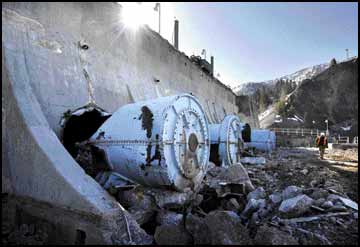But with the dam to be breached next month, researchers remain uncertain of how many fish, insects and other aquatic organisms will perish, how long that impact will last and how far downstream it will reach.
“Milltown is unique,” said state fisheries biologist Dave Schmetterling, who has been studying the dam's impacts for a decade. “There are a lot of unknowns we're dealing with. Nothing like this has ever been done before.”
But returning the river to its biological, physical and chemical origins will come at a short-term cost.
In mid-March, removal of the dam's powerhouse will start unleashing a massive amount of sediment - 300,000 cubic yards - scoured from the bottom for several months as the river returns to its natural level.
The sediment will be made up of sharply edged grains that hammer a fish population already weakened by decades of exposure to toxic mining metals that accumulated behind the dam.
The river will rush through the relatively small gap where the dam's powerhouse was located, generating a velocity of water so strong that migrating fish might not be able to pass through.
An estimated 250,000 fish gather each spring at the bottom of the 30-foot dam in an effort to migrate upstream.
The Clark Fork will have been diverted into a bypass channel, so the sediment being released will come from the Blackfoot River, which is not contaminated.
Schmetterling said the size of the fish kill will depend on water levels, water temperatures and other factors.
He said the river's 12 species of fish could be affected for three to five years, from the dam site to where the Bitterroot River joins the Clark Fork on Missoula's west side.
He praised the U.S. Environmental Protection Agency, which is in charge of the dam and sediment removal and channel restoration, for a number of project changes designed to minimize the impact on the fishery. Such changes include putting boulder clusters in the bypass channel and rocks in the river channel where the powerhouse was located to slow down the flow and help the movement of fish.
Hundreds of dams have been removed nationwide in recent decades, but authorities say none has involved the size, contaminants and other complexities of the Milltown project, which sits at the lower end of the largest Superfund site in the nation.
Schmetterling, with Montana Fish, Wildlife and Parks, has studied the population, movement, health and mortality of hundreds of caged trout and trout implanted with radio transmitters in the Clark Fork, Blackfoot and Bitterroot rivers at locations above and below the dam since 1998.
From 2005 to 2007,
100 percent of the caged fish died just below the dam, while 40 percent to 70 percent of the tagged fish died in the Clark Fork.
Tests showed the cause of death was a bacterial infection brought on by poor water quality and high water temperature.
The tests also showed the fish were already weakened by heavy metals and the stress of not being able to migrate, which have kept native fish populations in the Clark Fork below normal.
Schmetterling said he expected the resiliency, density and consistency of the fish population to increase over the long run as the river returns to its natural state, water quality improves, migration patterns are re-established, gravel bars re-emerge and predatory pike are reduced.
Reporter John Cramer can be reached at 523-5259 or at johncramer@missoulian.com.

